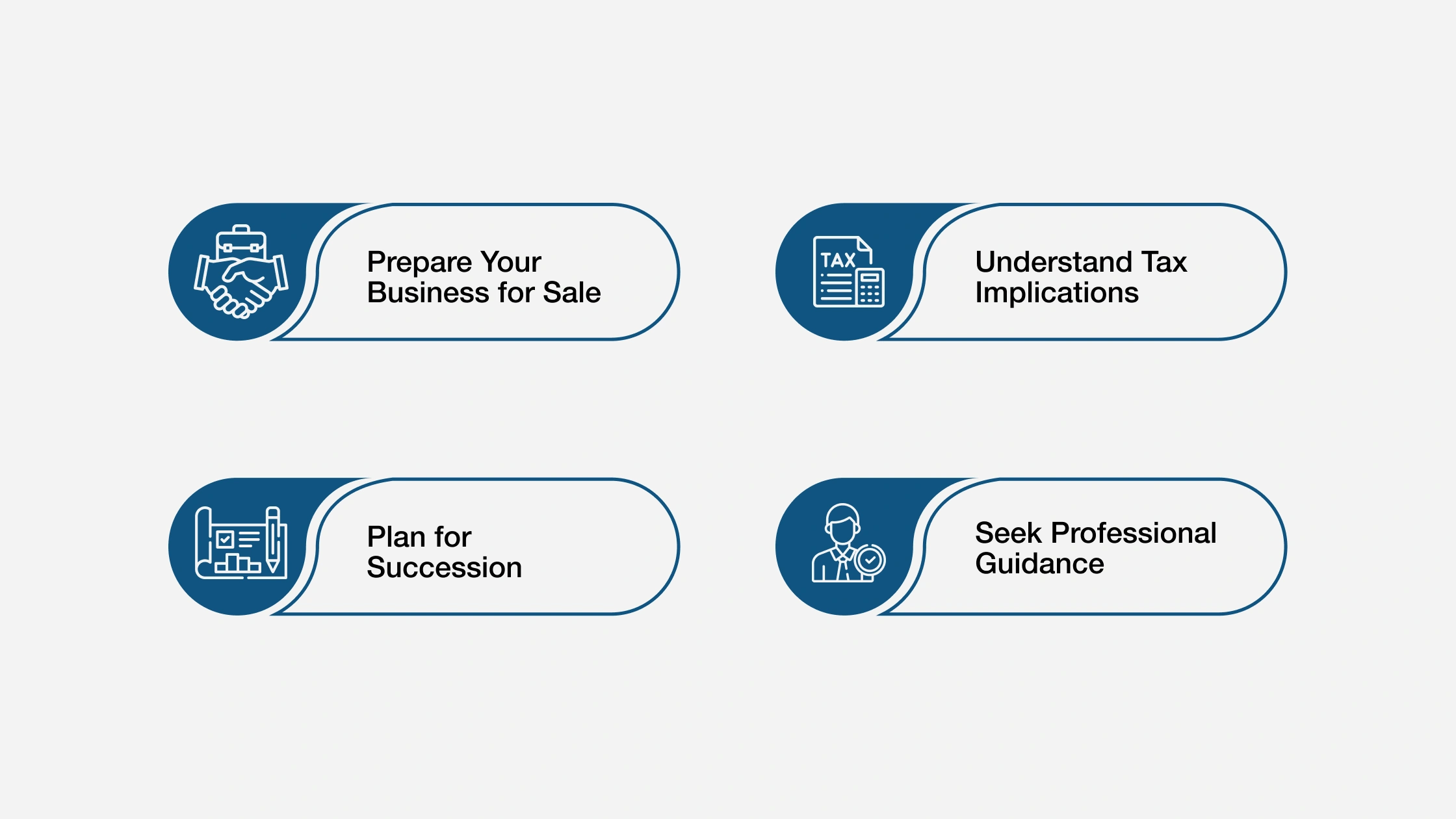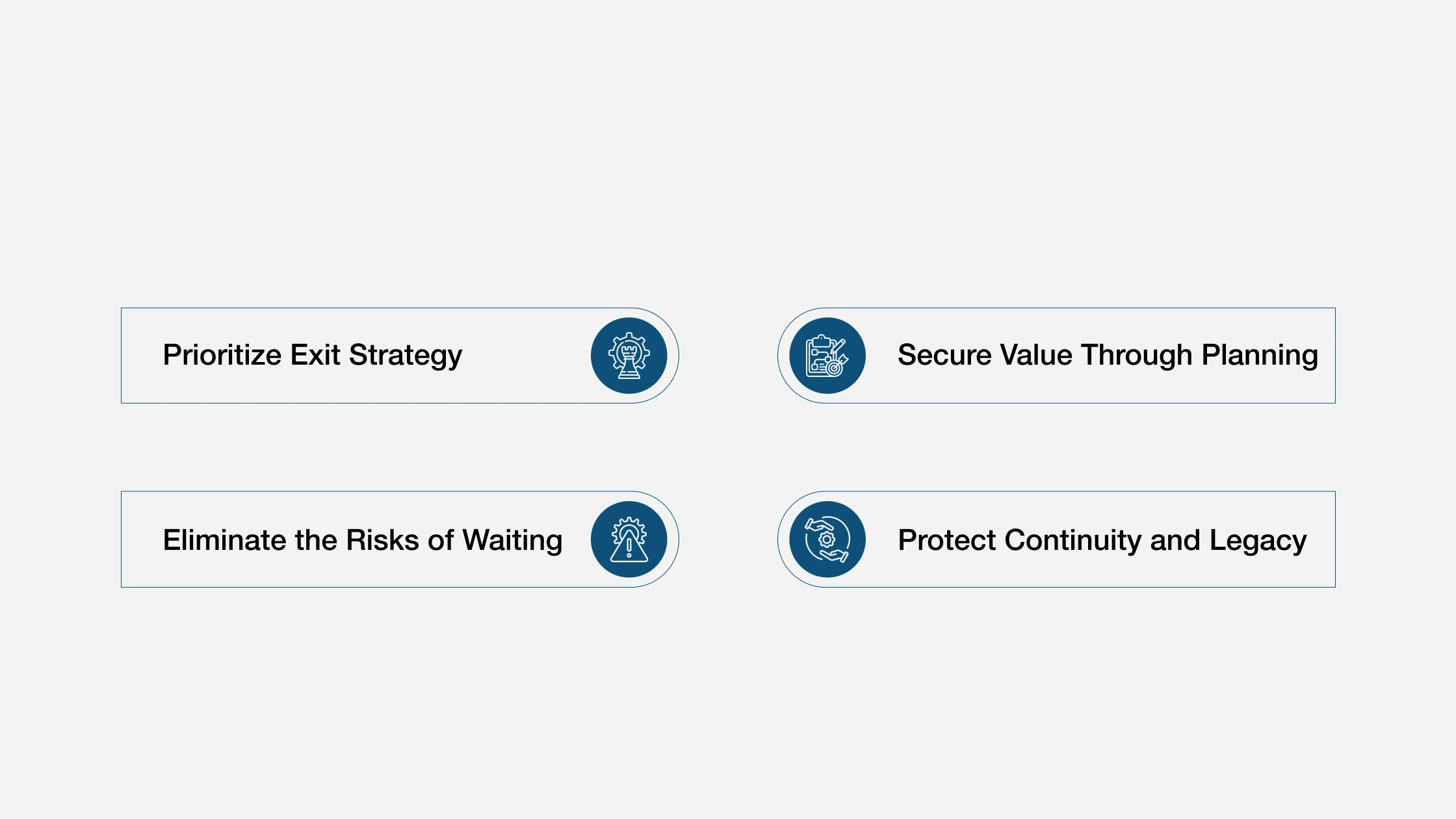Every business owner will eventually exit. The question is: will it be on their terms?
Most owners are so focused on day-to-day operations that long-term planning takes a back seat until something forces their hand. A sudden health issue, an unexpected offer, or a shift in personal priorities can accelerate the timeline. At that point, choices shrink, and value often gets left on the table.
Despite this reality, only 42% of business owners have a formal transition plan in place. The rest are exposed to unnecessary risk, personally, financially, and operationally.
For advisors, this reality is both a challenge and an opportunity. Owners urgently need structured guidance, and the professionals who can deliver it position themselves as indispensable partners in protecting value and shaping successful transitions.
Exit strategy means preparing for what lies ahead, not reacting to it. For small and mid-sized business owners, that preparation should begin well before the sale, and advisors are the ones best equipped to lead them there..
Why Is an Exit Strategy Critical for SMEs?
Exit strategy gives small and mid-sized business owners a framework to protect value, reduce risk, and make stronger decisions well before a transition.
1. Prioritize Exit Strategy
Too many small and mid-sized business owners view exit planning as something to deal with years down the road. In reality, an exit strategy is a core part of business management. Decisions about growth, leadership structure, and operational investment made today directly affect how transferable and ultimately valuable the company will be in the future.
Building an exit strategy into the business model ensures you’re positioning the business for tomorrow’s transition.
2. Secure Value Through Planning
For most owners, the business represents their single most significant financial asset. Studies show that as much as 80% of an owner’s net worth is tied directly to the company. Without a clear plan to safeguard, grow, and eventually extract that value, long-term security and retirement goals are vulnerable.
Exit planning creates a roadmap to protect what you’ve built, helping owners avoid costly mistakes that can erode wealth at the most critical moment.
3. Eliminate the Risks of Waiting
Not every exit is planned. Illness, divorce, disputes among partners, or economic disruption can force an owner’s hand sooner than expected. When a business is unprepared, the result is often a distressed sale, reduced valuations, or even collapse.
Owners who build exit planning into their operations have options, whether it’s restructuring, succession, or a sale on favorable terms. The earlier planning begins, the more control an owner has over timing and outcomes.
4. Protect Continuity and Legacy
Exit planning is also about protecting employees, leadership teams, and the culture you’ve built. An unplanned transition creates uncertainty, lowers morale, and can push top talent to competitors.
By embedding exit planning into everyday business management, owners ensure continuity for their teams and stability for the company. This preserves value and protects the legacy they’ve worked so hard to create.
What are the Real Business Costs of Not Planning?
The absence of a defined exit strategy carries tangible costs for business owners and their organizations. A rushed or reactive transition rarely delivers the full value of the business and can create ripple effects that extend far beyond the owner’s personal finances.
Without a proactive plan, businesses risk losing control over the terms of their exit and the future direction of the company.
- Reduced Valuation: Buyers are far less likely to pay a premium for a business that appears unprepared for transition. Missing documentation, inconsistent financials, or unclear leadership succession can sharply lower offers.
- Tax Inefficiencies: A poorly structured deal can leave significant money on the table. Without advance planning, owners may face higher capital gains taxes, estate taxes, or avoidable penalties that reduce their proceeds.
- Missed Opportunities: Market conditions change quickly. Owners without a plan may be unable to capitalize on favorable timing, strategic partnerships, or acquisition offers.
The damage isn’t limited to financial outcomes. Employees and leadership teams often feel the brunt of an unplanned exit. Operational uncertainty can disrupt productivity, weaken morale, and drive top talent to competitors. For many owners, protecting their company’s culture and people is just as important as protecting its value. Proper planning ensures both are preserved.
Exit Planning Timing and Mindset
Timing is one of the most overlooked aspects of a successful exit. Owners often wait until a transition feels imminent before considering their options, yet the reality is that meaningful value creation requires years of preparation.
Ideally, exit planning begins three to ten years before a transaction or transition. This window allows owners to enhance financial performance, strengthen management teams, address operational inefficiencies, and position the business for maximum valuation.
Equally important is adopting the right mindset. Exit planning is an ongoing strategic process that shapes how business owners manage their operations today. Every decision about investment, hiring, governance, and risk management can directly influence exit outcomes.
By treating exit planning as a present-tense activity, owners gain clarity, protect their wealth, and ensure their companies are resilient to unexpected changes. The earlier this process begins, the more control owners have over the legacy they leave behind.
Strategic Benefits of Early Exit Planning
Below are a few significant benefits of early exit planning:
- Strengthens the business today: Clearer financial decisions, leadership development, and scalable systems reduce bottlenecks.
- Builds resilience: Operations run more smoothly, making the company stronger before any transition.
- Creates flexibility: Owners can adjust strategies based on market shifts, personal goals, or timing.
- Improves negotiating power: Well-prepared businesses secure better deal structures and outcomes.
- Reduces owner dependency: Shared leadership and stronger governance build buyer and investor confidence.
- Supports smoother transitions: Independent systems and prepared teams lead to cleaner handovers.
- Enhances legacy: Planning protects culture, continuity, and long-term business value.
How to Build a Successful Business Exit Strategy

A strong exit strategy doesn’t happen overnight. It requires foresight, discipline, and the right expertise to maximize value while minimizing risks. Here are the core elements every owner should address:
1. Prepare Your Business for Sale
Clean financial statements, updated contracts, and streamlined operations are critical. Buyers and investors will scrutinize every detail, so presenting a well-organized, profitable company makes the process smoother and more rewarding.
2. Understand Tax Implications
Taxes can significantly affect your net proceeds. Capital gains, transfer taxes, and jurisdiction-specific rules all influence the outcome. Understanding these early and structuring your exit accordingly helps preserve wealth.
3. Plan for Succession
Leadership continuity is one of the biggest concerns in any transition. Whether you’re passing the business to family, employees, or a buyer, a clear succession plan reduces disruption and protects company stability during the changeover.
4. Seek Professional Guidance
Exit planning is a complex process, and missteps can be costly. Advisors in exit planning bring valuable insights that help owners structure deals, avoid pitfalls, and align the exit with long-term financial and personal goals.
What Role Do Advisors Play in Successful Exit Planning?
Business owners rarely manage exit planning alone. They rely on advisors who can bring structure, objectivity, and specialized knowledge to a complex process. For financial advisors, CPAs, consultants, attorneys, and part-time CFOs, exit planning is an opportunity to guide clients through the most important financial decision of their lives.
Advisors play a critical role in:
- Clarifying financial realities: Helping owners understand valuation drivers, risk factors, and potential deal structures.
- Coordinating expertise: Bringing together tax, legal, and operational specialists to build an integrated plan.
- Preparing leadership teams: Ensuring management continuity and reducing overdependence on the owner.
- Timing decisions strategically: Guiding owners on when to act to maximize valuation and minimize risk.
Owners often postpone difficult exit conversations until it’s too late. Advisors who take initiative, framing exit planning as part of everyday business strategy, position themselves as trusted partners, not just technical experts.
Advance Your Advisory Career with CBEC® Certification
Business owners need advisors who can guide them through real transitions, not just theory. The Certified Business Exit Consultant® (CBEC®) designation from the International Exit Planning Association (IEPA), equips professionals with the frameworks, resources, and practical training to manage complex exits from start to finish.
CBEC® certification is created for financial advisors, CPAs, consultants, attorneys, and part-time CFOs who want to strengthen their expertise, expand services, and deliver measurable results in Exit Planning engagements.
As a CBEC® designee, you gain:
- Comprehensive Exit Planning expertise: Structure phased transitions, minimize tax exposure, and unlock value owners can realize before, during, and after an exit.
- Hands-on, practical training: Apply frameworks directly to client work. IEPA data shows 66% of certified advisors break engagements into multiple phases for sustained value delivery.
- Exclusive resources: Access planning templates, financial models, case studies, and proven methodologies used by top practitioners.
- Peer collaboration and support: Join a nationwide network of professionals with shared experience and ongoing education.
- Credibility and recognition: Demonstrate real competence in Exit Planning, building trust with clients and standing out in a competitive market.
- Strong earning potential: 22% of CBEC® professionals report earning more than $250,000 annually from Exit Planning services.
If you’re advising business owners without a clear framework, or if you want to lead exit engagements with clarity and confidence, CBEC® certification provides the structure, credibility, and community to make it happen.






